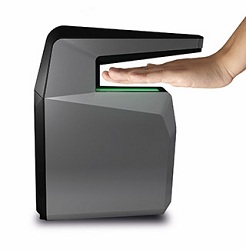
There are several important changes occurring worldwide that have created a growing demand for biometric systems to provide maximum throughput and convenience, with even higher levels of security. Gary Jones, VP Global Channel & Marketing at Idemia, Biometric Access & Time Solutions explains the growing demand for the company’s multi award winning Morphowave frictionless biometric technology.
The profile of the typical security decision maker is more IT oriented than ever, and is often someone who grew up with technology and convenience at their fingertips. Similarly the typical employee or user of any access control system also has a different mindset about technology than the type that existed 10 or 20 years ago. In general, the world has come to understand the benefits of using biometrics on a day-to-day basis as something that provides both security and convenience, whether by unlocking their phone with a fingerprint or face capture, or getting through a passenger fast-track system at an airport. As this comfort and familiarity grows, so do the expectations around biometrics.
Anyone in the security industry knows that convenience and security are typically considered to be inversely related; in other words, a tradeoff has to be made somewhere.
So how do we then double or triple the throughput of a biometric access control system without any compromise in security? We have five fingerprints on each of our hands, and each one is completely unique. In the past, it was difficult to scan more than one finger in an access control environment several major innovations by Idemia, according to Gary Jones, have changed the game completely.
Morphowave technology scans all four fingers in 3D with a simple wave of the hand. This touchless technology also ensures that approximately 30% more data per finger is captured than with traditional systems. The high-speed acquisition technology of Morphowave also captures multiple samples of each finger as the hand passes through the capture volume. All of this translates into a system which has roughly 50 times more data to match against for every transaction, when compared to traditional systems.
In biometrics, the more data you have to compare against, the more accurate the system will be, and the lower the rejection rates will be. Of equal importance, the touchless 3D imaging does away with concerns of wet or dry hands, and variations in skin condition that can adversely affect many contact-based systems.
The major breakthrough with Morphowave is that all this extra, higher quality data, is even easier for the user to provide than,for example, with a single finger contact fingerprint sensor. All that is needed, is a simple wave of the hand.
Jones explains that frictionless is more than just contactless. To have a truly frictionless biometric access system, users need to genuinely be able to keep moving, and have minimum inconvenience in the process. Idemia does not consider that systems that require pausing, stopping or changes in natural behaviour to be frictionless. Morphowave Technology is truly frictionless, and according to the company, allows users to walk as fast as they like.
Morphowave is capable of throughput exceeding 45 people per minute even with very large databases. Jones explains that many non-contact biometric systems are highly susceptible to external factors. Nature is tough to compete with, and many face and iris systems have limitations about where they can be deployed, due to the large fluctuations in natural and artificial light that can occur from site to site, or from day to day. Morphowave has been designed to operate in any conditions, from complete darkness to full sunlight, and anything in between.











